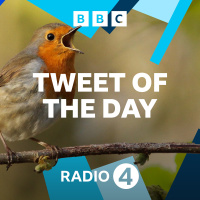Sinopsis
Discover birds through their songs and calls. Each Tweet of the Day begins with a call or song, followed by a story of fascinating ornithology inspired by the sound.
Episodios
-
Gabi Mann on the American crow
10/05/2017 Duración: 01minIn this programme young girl Gabi Mann recalls how she became friends with American crows in her suburban garden in Seattle, one of whom she named Baby Face. She and her mother began feeding the crows regularly in 2011 and soon the crows began bringing Gabi gifts. Over time these trinckets and corvid offerings amounted to a sizeable hoard which Gabi treasures.Producer Maggie Ayre.
-
Mat Waddington on the long tailed tit
09/05/2017 Duración: 01minWorcestershire lawyer Mat Waddington recounts an encounter with a long tailed tit tapping at his window, his girlfriend at the other end of the village was similarly visited by a long tailed window tapper. Was this the same bird flying between the two houses which Mat describes as being the lovebird of Hallow?Tweet of the Day has captivated the Radio 4 audience with its daily 90 seconds of birdsong. But what of the listener to this avian chorus? In this new series of Tweet of the Day, we bring to the airwaves the conversational voices of those who listen to and are inspired by birds. Building on the previous series, a more informal approach to learning alongside a renewed emphasis on encounter with nature and reflection in our relationship with the natural world.Producer Maggie Ayre.
-
Sam Lee on the nightingale
08/05/2017 Duración: 01minTweet of the Day has captivated the Radio 4 audience with its daily 90 seconds of birdsong. But what of the listener to this avian chorus? In this new series of Tweet of the Day, we bring to the airwaves the conversational voices of those who listen to and are inspired by birds. Building on the previous series, a more informal approach to learning alongside a renewed emphasis on encounter with nature and reflection in our relationship with the natural world.For this first programme, folk musician and Mercury Prize nominee Sam Lee considers the nightingale, that amazing songster which can use two voice boxes to produce over 200 different styles of phrasing; enriching the gathering darkness for those fortunate enough to hear. Having sung with nightingales in Sussex woodlands for many years, for Sam that richness of the male nightingale territorial song, is mesmeric.Producer Maggie Ayre.
-
Dawn Chorus
07/05/2017 Duración: 27minThe best bits of International Dawn Chorus day when radio stations across the globe come together and broadcast the dawn chorus in real time.Pop star and bird lover Will Young joins Brett Westwood and a gang of unexpected bird lovers as Radio 4 throws an all-nighter in search of the Dawn Chorus. Going on air just after midnight and staying up till 7am Brett and Will host a night of conversation, story-telling, argument and explanation culminating in the live broadcast of the Dawn Chorus from Ham Wall Nature reserve in Somerset.Other guests include Birds Brittania author Mark Cocker, Bird acoustics expert Dr Jenny York and singer Hanna Tuulikki.Radio 4 is doing this as part of International Dawn Chorus day - a unique broadcast event hosted by RTE in Ireland - in which radio stations in India and Europe join together to track the rising sun across the continent from Delhi to Dublin. You'll hear capercaillies in from Norway, bitterns in Somerset, bluethroats in Holland - it's like the Eurovision Song contest, bu
-
Chowchilla
13/02/2015 Duración: 01minMichael Palin presents the secretive chowchilla from Queensland, Australia. The chowchilla gets its name from its song, which is one of the most distinctive sounds of the coastal rainforest of north-east Queensland. You're not likely to see the bird though because it spends its time skulking on the forest floor. Chowchillas belong to the family known as logrunners because they feed and nest on or near ground-level. They're stout thrush-like birds; the males are dark brown with a white chest and throat, whilst the female's throat is rusty-orange. Chowchillas have been found to sing with different dialects in different areas. Within say, 50 hectares, all the family groups of pairs and non-breeding younger birds may share the same dialect. But in an adjacent area, the families may assemble some of their song components slightly differently. Over time, their song culture could change and a new dialect would be born.Producer : Andrew Dawes
-
Mauritius Kestrel
12/02/2015 Duración: 01minMichael Palin presents the Mauritius kestrel from the island of Mauritius. Today the calls of several hundred Mauritius kestrels ring out across the forests and farmland of the island, so it's hard to believe that as recently as the early 1970s, only four birds could be found in the wild.These smart chestnut falcons were almost wiped out by a cocktail of threats ...destruction of their evergreen forests, pesticides and the introduction of predators such as monkeys, mongooses, rats and cats. When a species is so critically endangered there aren't many options, and conservationists decided that their only choice was to take some of the wild Mauritius kestrels into captivity.By 1993, 300 Mauritius kestrels had been released and by November of that year there were as many as 65 breeding pairs in the wild. Now the kestrels are back, hovering above the landscapes that nearly lost them forever.Producer : Andrew Dawes
-
Ostrich
11/02/2015 Duración: 01minMichael Palin presents the avian record breaking ostrich in the Kalahari Desert. Ostriches are ornithological record-breakers. The black and white adult male ostrich is taller and heavier than any other living bird, reaching almost 3 metres in height and weighing a whopping 150 kilograms. Females are smaller but lay the largest eggs of any bird. The ostrich's eye measures 5cm in diameter and is the largest of any land vertebrate.Ostriches live in the wide open landscapes of central, eastern and South-West Africa. As well as being tall and observant, Ostriches also minimise their chances of being predated on, by living in groups and sharing lookout duties, or staying close to sharp-eyed antelope and zebra herds. They can also use their powerful legs to try and outrun a predator, reaching speeds of up to 70 kilometres per hour which makes them the fastest avian runner.
-
Asian Koel
10/02/2015 Duración: 01minMichael Palin presents the Asian koel's arrival to an Indian orchard. This long-tailed glossy blue-black bird, is a well-known British harbinger of spring, and like its British counterpart, it is a cuckoo.The koel's plaintive call is heard from late March until July around villages and in wooded countryside from Pakistan east to Indonesia and southern China. In India, it symbolises the birth of a new season, the flowering of fruit-trees, the bloom of romance and all that's good about spring. The koel's song can be heard in many Bollywood movies and has inspired poems and folk songs; it's even rumoured to help mangoes ripen faster.This almost universal feel-good factor doesn't extend to its victims, because the koel is after all a cuckoo, and lays its eggs in other birds' nests. Asian Koels are parasitic on a wide range of birds, but in India especially, on House Crows and Jungle Crows. Producer Andrew Dawes.
-
Northern Cardinal
09/02/2015 Duración: 01minMichael Palin presents the northern cardinal from a New York's Central Park. Northern Cardinals are finch-like birds and make British robins look positively anaemic. They are common residents in the south and east of North America where they live in woods, parks and gardens. Your first sighting of these vermilion birds with their black masks and outrageous crests comes as a shock. They seem too tropically colourful to brave the dull North American winter. Only the male Cardinals are bright red. Females are browner with flashes of red on their wings and red bills. Both sexes obtain their red colours from seeds and other foods which contain carotenoid pigments. Their familiarity and eye-catching colours have endeared cardinals to North Americans. No fewer than seven states, including Kentucky, Illinois and Ohio have adopted cardinals as their state bird and it's also the mascot of many famous sports clubs including the St. Louis Cardinals baseball team.Producer : Andrew Dawes
-
Black-nest Swiftlet
06/02/2015 Duración: 01minMichael Palin presents the black-nest swiftlet deep inside an Indonesian cavern. The Black-nest swiftlet landing on the cave wall, begins work on one of the most expensive and sought- after items connected with any bird; its nest.The swiftlet's tiny bowl -shaped nest is highly-prized as the main ingredient for bird's nest soup and is built by the male from strands of his saliva which harden into a clear substance which also anchors the nest to the vertiginous walls. Black-nest swiftlets are so-called because they add dark-coloured feathers to their saliva which are then incorporated into their nests.The nests fuel expensive appetites. A kilo of nests can fetch 2500 US dollars and worldwide the industry is worth some 5 billion US dollars a year. Today in many places in South-east Asia artificial concrete "apartment blocks" act as surrogate homes for the Black-nest swiftlets. The birds are lured in by recordings of their calls, and once they've begun nesting, the buildings are guarded as if they contained gold
-
Magnificent Frigatebird
05/02/2015 Duración: 01minMichael Palin presents the magnificent frigatebird a true oceanic bird, and resembling a hook-billed, pterodactyl of a seabird.Magnificent frigatebirds are some of the most accomplished aeronauts of the tropical oceans. Their huge wingspans of over two metres and long forked tails allow them to soar effortlessly and pluck flying fish from the air, and also harass seabirds. These acts of piracy earned them the name Man-o' War birds and attracted the attention of Christopher Columbus. Magnifcent Frigatebirds breed on islands in the Caribbean, and along the tropical Pacific and Atlantic coasts of central and South America as well as on the Galapagos Islands. Frigatebird courtship is an extravagant affair. The males gather in "clubs" , perching on low trees or bushes.Here they inflate their red throat-pouches into huge scarlet balloons, calling and clattering their bills together as they try to lure down a female flying overhead. If they're successful, they will sire a single chick which is looked after by both
-
Budgerigar
04/02/2015 Duración: 01minMichael Palin presents the wild budgerigar from Australia. Budgerigars are small Australian parrots whose common name may derive from the aboriginal "Betcherrygah' which, roughly speaking, means "good to eat" though it could mean " good food" as budgerigars follow the rains and so their flocks would indicate where there might be seeds and fruits for people.Where food and water are available together; huge flocks gather, sometimes a hundred thousand strong, queuing in thirsty ranks to take their turn at waterholes. Should a falcon appear, they explode into the air with a roar of wingbeats and perform astonishing aerobatics similar to the murmurations of starlings in the UK.Although many colour varieties have been bred in captivity, wild budgerigars are bright green below, beautifully enhanced with dark scalloped barring above, with yellow throats and foreheads. With a good view, you can tell the male by the small knob of blue flesh, known as a cere, above his beak.
-
American Bald Eagle
03/02/2015 Duración: 01minMichael Palin presents the iconic bald eagle from Alaska. In days of yore, when bald meant "white" rather than hairless, these magnificent birds with a two metre wingspans were common over the whole of North America. They were revered in native American cultures. The Sioux wore eagle feathers in their head-dresses to protect them in battle and the Comanche celebrated the birds with an eagle dance.The bird became a national symbol for the United States of America and on the Great Seal is pictured grasping a bunch of arrows in one talon and an olive branch in the other.But pomp and reverence don't always guarantee protection. In 1962 in her classic book "Silent Spring", Rachel Carson warned that bald eagle populations had dwindled alarmingly and that the birds were failing to reproduce successfully. Rightly, she suspected that pesticides were responsible. Bald eagle populations crashed across the USA from the middle of the twentieth century, but fortunately are now recovering following a ban on the use of the o
-
Scarlet Macaw
02/02/2015 Duración: 01minMichael Palin presents the scarlet macaw from Costa Rica. The Scarlet Macaw is a carnival of a bird, eye-catching, noisy and vibrant, with a colour-scheme verging on bad taste. Its brilliant red feathers clash magnificently with the bright yellow patches on its wings, and contrast with its brilliant blue back and very long red tail. It has a white face and a massive hooked bill and it produces ear-splitting squawks. Subtlety is not in its vocabulary.Scarlet macaws breed in forests from Mexico south through Central America to Bolivia, Peru and Brazil. They use their formidable beaks not only to break into nuts and fruit, but also as pick-axes. Colourful and charismatic birds usually attract attention and in some areas where the Scarlet Macaws have been collected for the bird trade, numbers have declined. In south-east Mexico where they are very rare, a reintroduction programme is underway to restore these gaudy giants to their ancestral forests.Producer Andrew Dawes.
-
Kea
30/01/2015 Duración: 01minMichael Palin presents the kea from a windswept mountain in New Zealand. A a snow-capped mountain in New Zealand's South Island are not a place where you'd expect to find a parrot, least of all a carnivorous one (and with a penchant for rubber). But this is the home of the kea.Keas are curious birds in every sense of the word. Drab greenish brown, they're the world's only Alpine parrot. When they can find them, keas eat fruits and berries, but also, especially in winter they descend from the higher slopes and scavenge on animal carcasses at rubbish dumps, cracking bones with their sharp beaks to reach the marrow. They will even attack live sheep, stripping the fat from their backs and damaging vital organs. Although this habit is rare and is now understood to be largely restricted to injured sheep, it led to widespread persecution of the birds and a bounty was paid on the head of each bird killed which led to widespread declines so that keas became endangered.Today Keas are legally protected. In their mountai
-
Black Sicklebill
29/01/2015 Duración: 01minMichael Palin presents the black sicklebill of New Guinea. The black sicklebill is a breath-taking creature. It's a bird of paradise, and the male sicklebill's black feathers gleam with metallic blue, green and purple highlights. But his most striking features are a slender scythe-like bill, and an extremely long sabre-shaped tail whose central plumes can reach 50cm in length.During courtship, he transforms his pectoral and wing feathers into a huge ruff which almost conceals his head and exposes an iridescent blue patch. Perching on a dead branch, he displays horizontally, looking less like a bird than a small black comet, all the while producing strange rattling cries.It is thought that the Black sicklebill and its relative the Brown Sickle bill may have spooked the Japanese in the Second World War. Japanese forces had occupied the North coast of (Papua) New Guinea and during their push south to the capital, Port Moresby, had to cross the mountain territories of the sicklebills. It's said that on hearing th
-
Oilbird
28/01/2015 Duración: 01minMichael Palin presents the oilbird, from a Venezuelan cavern. Demonic screeching's and the rush of unseen wings mixed with a volley of strange clicks are the sound backdrop to oilbirds.Oilbirds are known in Spanish as guacharos .."the wailing ones". These bizarre-looking brown birds with huge mouths, long broad wings and long tails were seen in 1799 by the explorer Alexander von Humboldt in 1817 who described their sounds as "ear-splitting". They're similar to nightjars, their closest relatives, but unlike them, oilbirds feed on fruit; ..... they're the world's only nocturnal flying fruit-eating bird.In their dark breeding caves, they navigate using echolocation like bats. Young oilbirds grow fat on a diet of fruit brought in by their parents and can weigh half as much as again as the adults. These plump chicks were once harvested by local people and settlers for oil which was used in cooking and, ironically for a bird which spends its life in darkness, for lighting lamps.Producer : Andrew Dawes
-
Poorwill (American Nightjar)
27/01/2015 Duración: 01minMichael Palin presents the common poorwill from an Arizona desert. In the dead of night, loud calls pierce the stillness on a moonlit track, a small shape suddenly sprouts wings and flutters into the darkness ... a Common Poorwill is hunting.Poorwills are small nightjars that breed mainly in western North America, often in deserts and dry grassland. By day the poorwill sits in the open or among rocks relying on its mottled plumage for camouflage. By night, it emerges to hawk after insects snapping them up with its large frog-like mouth.This technique works if it's warm enough for insects to be active, but in some places where poorwills live there are sudden cold snaps. Instead of migrating, the poorwill slows down its metabolism and goes into torpor for days or even weeks . This hibernation-like state is very rare among birds and allows the poorwill to get through lean periods and was first scientifically described in 1948, although the phenomenon had been recorded more than 140 years earlier by the great exp
-
Red-Eyed Vireo
26/01/2015 Duración: 01minMichael Palin presents the red-eyed vireo from North America. About the size of British great tits the red-eyed vireo is a common summer visitors to much of North America where they breed in woodlands. The adult vireos are mainly olive green with white bellies and grey heads and their red eyes are highlighted by a white eyestripe. Seeing the birds as they hunt insects among the leaves is much harder than hearing them, because red-vireos are tireless songsters. They used to be known locally as "preacher birds " and territorial males hold the record for the largest repertoire produced by a songbird in a single day.Each vireo can have a repertoire of between a dozen and over a hundred different song-types. And while these marathon "question- and- answer" sessions are the soundtrack to many North American woods, they aren't universally appreciated. The nature writer Bradford Torrey wrote in 1889 that "whoever dubbed this vireo the preacher could have had no very exalted opinion of the clergy"Producer Andrew Dawes
-
Snail Kite
23/01/2015 Duración: 01minMichael Palin presents the snail kite from the Florida Everglades. Unlike many birds of prey which are known for their speed and agility, the snail kite hunts at a leisurely pace, one which matches its prey; and here in Florida's swamps, it is on the lookout for the apple snail.To pick them out of floating vegetation, the kite has evolved long needle-like claws, and its slender, viciously-hooked bill is perfect for snipping the snails' muscles and winkling them out of their shells. Snail kites are common across wetlands in South and Central America, but rare in Florida where there are around one thousand birds. Drainage of these marshes has made them scarce, but popular with bird watchers.It's easy to see why, because snail kites are striking birds with their orange feet and black and red bill. The males are ash-grey apart from a white band at the base of their tails. Females and young birds are browner and more mottled. In times of drought, they will eat turtles, crabs or rodents, but these avian gourmets al














